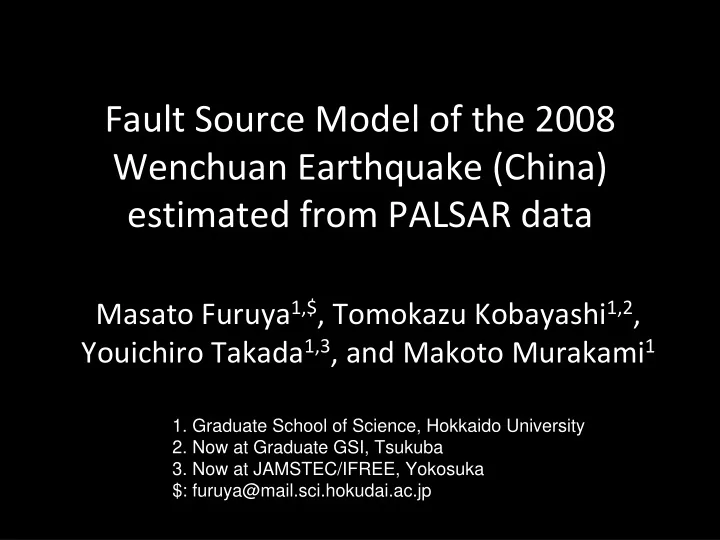

Fault Source Model of the 2008 Wenchuan Earthquake (China) estimated from PALSAR data Masato Furuya 1,$ , Tomokazu Kobayashi 1,2 , Takada 1,3 , and Makoto Murakami 1 Youichiro 1. Graduate School of Science, Hokkaido University 2. Now at Graduate GSI, Tsukuba 3. Now at JAMSTEC/IFREE, Yokosuka $: furuya@mail.sci.hokudai.ac.jp
Outline of this talk • The 2008 Wenchuan eqk. Observed by ALOS/PALSAR ‐ InSAR data, Pixel Offset data – • Fault Source Modeling • Summary PALSAR: L-band SAR sensor on ALOS( だいち )
Koyabashi et al. (2009, GRL) Today ; Revise a part of the observation data Update the preliminary source model
Longmen Shan Fault Zone and Data Coverage Fault traces by Densmore et al. (2007) 3 major faults
Ascending Orbit look
Pixel offset: Range component
Pixel offset: Azimuth component
Range component Azimuth component Simpler fault motion to the NE
Azimuth offset Range offset Two faults are necessary to the SW
Conjugate fault to the SW suggested from aftershocks Global CMT (USGS location) Mw > 5 主断層に交差する軸上で顕著な余震 小魚洞 (Xiaoyudong) での大変位 � “ 共役 ” 断層 (?) も動いた
Fault Models from Waveform Inversion Hikima, 2008 (ERI) Yamanaka, 2008 (NGY) Nishimura & Yagi, 2008 (Tsukuba) Ji, 2008 (UCSB)
Fault Source Model Fixing the location and geometry, we let slip distributions to be the unknowns.
“Original” Unwrapped InSAR data Derived from Minimum-Cost-Flow approach …unwrap the entire image “smoothly” across the fault Obvious jumps across the fault trace ! We let the amount of jumps the other unknowns that are solved together with the slip distribution.
The solved equation • Data d : InSAR, Range offset, Azimuth offset • Multiple patch size • Smoothness constraint on the slip distribution • Non ‐ negativity constraint on the slip vector
InSAR (“Obs”) InSAR (Cal) Residual 1.0 In the ”Obs” 0.5 Path 473 の北側 125.4cm Path 474 の北側 104.1cm meter 0 Path 475 の北側 96.8 cm -0.5 の offset が推定された. -1.0
Range offset (Obs) Range offset (Cal) 2 Residual 1 meter 0 -1 -2
Azimuth offset (Obs) Azimuth offset (Cal) 1.5 Residual 1.0 0.5 meter 0 -0.5 -1.0 -1.5
Range offset Azimuth offset Predicted Pixel offset depending on the assumed Dip=50 deg dip angle of F1 (NE) Range offset Dip=60 deg Insensitive to the dip Azimuth offset Dip=70 deg Sensitive to the dip Near vertical dip angle Dip=80 deg
Range offset Azimuth offset Predicted Pixel offset depending on the assumed Dip=40 deg dip angle of F5 (SW) Range offset Dip=50 deg Insensitive to the dip Azimuth offset Dip=60 deg Sensitive to the dip Shallower dip angle Dip=70 deg
Estimated slip distribution
Estimate of errors in the slip distribution
Summary • Pixel offset data revealed detailed image of the fault motion responsile for the 2008 Wenchuan earthquake at Longmen Shan Fault Zone. • Yingxu ‐ Beichuan fault and Anxian ‐ Guanxuan (Pengguan) fault to the SW were involved. • No evidence for the active motion at Wenchuan ‐ Maowen fault. • Geodetic Moment Magnitude Mw = 7.9 • Characteristics of the inferred fault motion: (1) Right lateral slip to the NE (2) Near vertical dip angle to the NE (3) Two fault planes to the SW, including thrust components (4) Shallower dip angle (~35deg) to the SW (5) Maximum slip to the NE (~10 m at shallower depth) (6) Conjugate fault to the SW
Acknowledgement • PALSAR level 1.0 data were provided from the Earthquake Working Group and PIXEL (PALSAR Interferometry Consortium to Study our Evolving Land surface) under a cooperative research contract with JAXA (Japan Aerospace Exploration Agency). • The PALSAR data belongs to METI (Ministry of Economy, Trade and Industry) and JAXA. • This study is supported from KAKENHI (19340123 and 20900002).
Recommend
More recommend